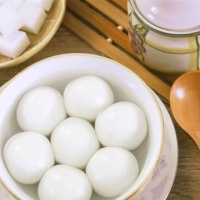- Home Page
- Fact Tours
Our sample tour itineraries of China and China travel packages are sorted by theme and available at competitive prices, you can browse what tours are right for you for your trip to China.
Popular China Tour Packages

Custom Tour Packages to China and Ask Our Experts for Free Enquiry !
- Coach Tours
- Destinations
Beijing, the capital of China. Its art treasures and universities have long made it a center of culture and art in China.
Beijing Top Attractions
Beijing City Tours
Best China Tours with Beijing
Shanghai, the cultural and economic center of East Asia. It renowned for its historical landmarks, the extensive and growing skyline.
Shanghai Top Attractions
Shanghai City Tours
Best China Tours with Shanghai
Xi'an, having held the position under several of the most important dynasties. It is the top destination to explore the facts of Chinese history.
Xi'an Top Attractions
Xi'an City Tours
Best China Tours with Xi'an
Huangshan boasts its culture, beautiful rivers, villages and mountains. It's home to 2 UNESCO World Heritage Sites and the Mecca of photographers.
Huangshan Top Attractions
Huangshan City Tours
Best China Tours with Huangshan
Sichuan is the cradle of the Shu culture, panda, mahjong, teahouse and spicy food. The province ranks first in China by number of UNESCO World Heritage Sites. It is called "the Heaven of Abundance".
Sichuan Top Attractions
Sichuan Tour Packages
Best China Tours with Sichuan
Yunnan, literally means the south of colorful clouds, due to its beautiful landscapes, mild climate and diverse ethnic cultures and traditions, is one of China's major tourist destinations.
Yunnan Top Attractions
Tibet, the nearest land to the sky, is known for its breathtaking landscape, splendid culture, art, buildings, and mysterious religions.
Tibet Top Attractions
Tibet Tour Packages
Best China Tours with Tibet
Explore the lost civilizations by riding a camel! Travel across the Gobi and the desert, and over the high mountains. Our Silk Road tours including different sections of the Silk Road in China.
Silk Road Top Attractions
Silk Road Tour Packages
Best China Tours with Silk Road
Guilin, an internationally-known historical and cultural city, has long been renowned for its unique karst scenery. Its vicinities are the paradise of hiking, caving, rafting, biking and countryside exploring.
Guilin Top Attractions
- China Facts
- China Hotels
- Travel Photos
Traditional Chinese Festivals
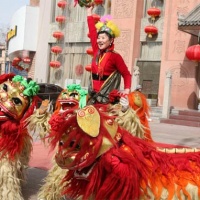 1. Introduction to Chinese Spring Festival
1. Introduction to Chinese Spring Festival
Spring Festival, popularly called 'Guo Nian' in Chinese and means passing year in English, is the most widely observed festival throughout the year in the whole country. Chinese Spring Festival or the Chinese Lunar New Year, is the new year of Chinese traditional lunar calendar. To the Chinese people it is as important as Christmas to people in the West. It is spent between January and February: The exact date varies, depending on Chinese Lunar Calendar. For example, Chinese New Year's Day in 2009 was on January 26. The year 2009 is the Year of Waterbuffalo in Chinese zodiac system.
Things to do at The Spring Festival
Preparations for the Spring Festival or Chinese New Year begin the last few days of the last moon. The first thing is to clean houses thoroughly. The cleaning often starts from Feb. 24 on Chinese lunar calendar. In Chinese opinion, the 'Cleaning' also includes debts repaid, hair cut and more... What they do just means that they want to meet a completely new year without any unpleasant thing.
2. Chinese Lantern Festival
The Lantern Festival or Yuanxiao Jie is a traditional Chinese festival, which is on the 15th of the first month of the Chinese Lunar New Year. Chinese values the date as the first full-moon night and organize some activities to celebrate it. This festival marks the end of the celebrations of the New Year. Chinese started to celebrate the Lantern Festival from the Han Dynasty (206 BC - 221 AD). Like most other Chinese festivals, there is also a story behind the Festival. It is also believed that the festival has Taoist origins.
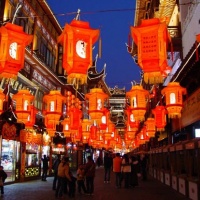 Things to do for this festival
Things to do for this festival
Chinese people go to a temple fair to enjoy all kinds of performances, to taste various unique local foods from different places. This is a festival for people having fun. On the night of the festival, people go on streets with a variety of lanterns under the full moon, watching lions or dragon dancing, playing Chinese riddles and games, and lighting up firecrackers. There is really a lot of fun for the young and the old.
Yuanxiao (glutinous rice ball) or Tangyuan is the special food for the Lantern Festival. It is believed that Yuanxiao is named after a palace maid, Yuanxiao, of Emperor Wu Di of the Han Dynasty. Yuanxiao is a kind of sweet dumpling, which is made with sticky rice flour filled with sweet stuffing. And the festival is named after the famous dumpling. Yuanxiao is sticky, sweet and round in shape, symbolizing family unity, completeness and happiness.
You can find Yuanxiao in oriental food stores. If you enjoy cooking, here is a recipe of Yuanxiao for you. Ingredients: 4 1/2 cups (500 g) sticky rice flour, butter 7 oz (200 g), black sesame powder 7 oz (200 g), sugar 8 oz (250 g), 1 tsp wine
1. Mix the butter with sesame powder, sugar and wine together. You need to heat a little bit. Make small balls about 0.3-0.4 oz (10 g) each.
2. Take 1/2 cup of sticky rice flour. Add water into the flour and make a flatten dough. Cook it in boiled water and take out until done. Let it cool down. Then put it in the rest of the sticky rice flour. Add water and knead until the dough is smooth.
3. Make the dough into small pieces about 0.3-0.4 oz (10 g) each. Make it like a ball using hands first and then make a hole in the ball like a snail. Put the sesame ball into it and close it up.
4. Cook them in boiled water. Make sure to keep stirring in one direction while cooking. When they float on the water, continue to boil for about one minute using less heat.
The festival is not well celebrated in the US, though you may find celebrations in some Chinese communities, such as Hsi Lai Temple, Hacienda Heights, California.
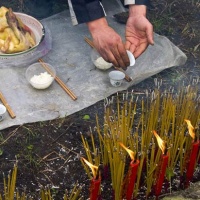 Tomb-sweeping Day is also well known as 'Qing Ming Festival' in Chinese. Its date can be found on Chinese lunar calendar. The name 'Qing Ming' is one of twenty-four Chinese solar terms. Chinese people used to arrange agricultural activity according to twenty-four solar terms. Each solar term means temperature, rainfall such kind of climate elements at a time of a year. The solar term 'Qing Ming' means clear and bright and is a good time for plough and planting.
Tomb-sweeping Day is also well known as 'Qing Ming Festival' in Chinese. Its date can be found on Chinese lunar calendar. The name 'Qing Ming' is one of twenty-four Chinese solar terms. Chinese people used to arrange agricultural activity according to twenty-four solar terms. Each solar term means temperature, rainfall such kind of climate elements at a time of a year. The solar term 'Qing Ming' means clear and bright and is a good time for plough and planting.
In fact, Qing Ming Festival is a traditional day for Chinese to pay mourning or sacrifice for the dead and ancestors although its name is a solar term. That is why Qing Ming Festival is translated into Tomb-sweeping Day in English. This festival can be traced back to the Zhou dynasty.
Things to do on Tomb-sweeping Day
When the day comes, Chinese people often prepare some special food like date or wheat cake (in north), sticky rice (in south) at home. Then they go out with food, fruits and more sacrificing articles to the tombs in the fields. They refresh the earth covered on tombs; make a simple rite: set the food, fruits, burn incense, candle and joss paper as an offering, stand in a courtesy or a silence tribute to the dead before tombs. At last, the rite ends with letting off cracker works.
4. Dragon Boat Festival
Dragon Boat Festival, one of the oldest Chinese traditions, is May 5 on Chinese lunar calendar. According to the prevailing sayings among Chinese folklore, the festival is used to memorize a great patriotic poet - Quyuan whose wrote influential works like 'Li Sao' in Chinese literature.
Quyuan was a high official of Chu state at the Spring and Autumn Annals in ancient China.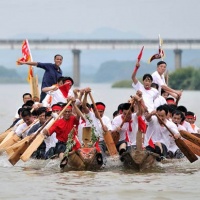 He put forward policies and encouraged the king of Chu to make his state stronger. But his action was rejected by noble men of Chu state. Then he was entrapped by evil (speaking) and dismissed by the king. At the following time, he wrote a number of famous literary works to express deep worry about his state. Later on, the territory of the Chu state was invaded and occupied by Qin - another strong state at that time. Quyuan saw that; with extreme grief and indignation, he committed a suicide by jumping into a river on May 5. The mass of the Chu were touched by his patriotic action, they used their ways to offer mourning to Quyuan after his death. The date and the ways were developed into a custom, a festival.
He put forward policies and encouraged the king of Chu to make his state stronger. But his action was rejected by noble men of Chu state. Then he was entrapped by evil (speaking) and dismissed by the king. At the following time, he wrote a number of famous literary works to express deep worry about his state. Later on, the territory of the Chu state was invaded and occupied by Qin - another strong state at that time. Quyuan saw that; with extreme grief and indignation, he committed a suicide by jumping into a river on May 5. The mass of the Chu were touched by his patriotic action, they used their ways to offer mourning to Quyuan after his death. The date and the ways were developed into a custom, a festival.
Things to do at Dragon Boat Festival
When this festival comes, Chinese people do a list of things: married women come back home to see their parents; the doors and windows are put up with some joss paper or special plants for exorcizing the ghost or evil things from the house; children are given little aroma pouch for luckiness; drink some medicated liquor for health; favorite food like rice dumpling (zongzi in Chinese) are enjoyed; games are played and the dragon boat race is most popular. More details...
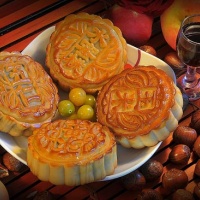 Middle-autumn Festival is originated from ancient sacrifice rite for goodness of moon. This festival was developed into a tradition in the Tang dynasty. In Chinese people's opinion, Aug 15 on Chinese lunar calendar is a date when the fullest moon comes in a year. At the night of the date, Chinese people look the clean and bright full moon as a symbol of reunion. Especial for people who have go out from home for a long time, they use the full moon to pray the goodness for future reunion and express that they are missing their hometown and families. More details...
Middle-autumn Festival is originated from ancient sacrifice rite for goodness of moon. This festival was developed into a tradition in the Tang dynasty. In Chinese people's opinion, Aug 15 on Chinese lunar calendar is a date when the fullest moon comes in a year. At the night of the date, Chinese people look the clean and bright full moon as a symbol of reunion. Especial for people who have go out from home for a long time, they use the full moon to pray the goodness for future reunion and express that they are missing their hometown and families. More details...
Things to do at Middle-autumn Day
When this festival comes, Chinese always enjoy a feast of family reunion. Then under a full moon appear at the night, many people like to sit down at opening places for a small family party, enjoy delicious moon cakes; young girls make a vow to goodness of moon and wish that she will grow up to be so beautiful as the goodness.
Questions & Comments
Home | About Us | Partnerships | Terms & Conditions | Privacy & Security | Payment Guide | Resource Links| Sitemap
Email: contact@chinafacttours.com, Tel: +86-773-3810160, Fax: (+86) 773-3810333
Copyright © 2008-2022 China Fact Tours. All rights reserved
![]()










